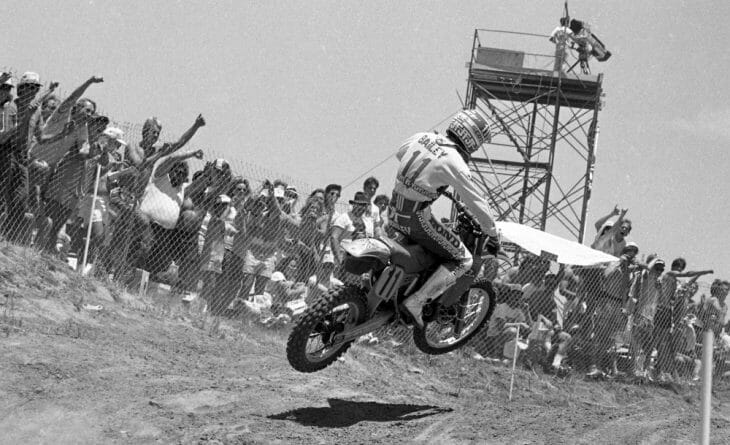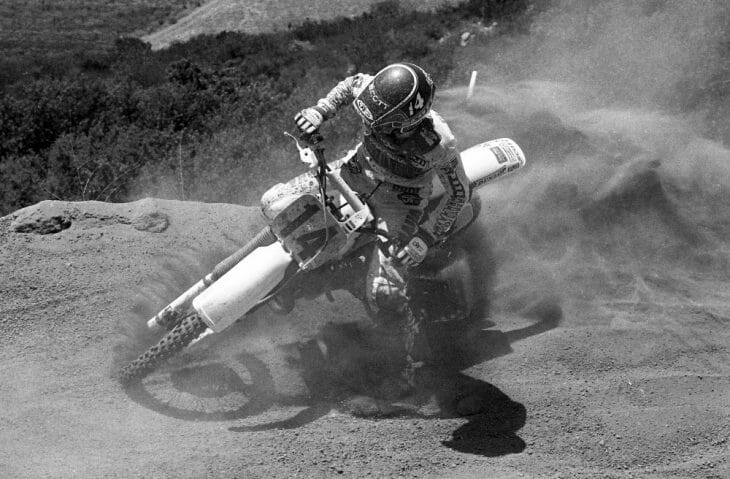Larry Lawrence | November 15, 2017
 The fans cheered on David Bailey, who ran strategic motos to perfection to win the 1985 Carlsbad USGP in spite of not being 100 percent healthy. (Mitch Friedman Collection)
The fans cheered on David Bailey, who ran strategic motos to perfection to win the 1985 Carlsbad USGP in spite of not being 100 percent healthy. (Mitch Friedman Collection)
It was a big showdown between David Bailey and Broc Glover. The backdrop was the world stage as the two battled for victory in the 1985 Nissan United States Grand Prix of Motocross at the iconic motocross track in Carlsbad, California. Glover was at the top of his game and supremely confident. He would go on that year’s AMA 500cc Motocross title in spite of riding an air-cooled Yamaha YZ490 that was behind the times as compared to Bailey’s state-of-the-art liquid-cooled Honda CR500. Glover was the fastest rider on the track that day at Carlsbad, but in unpredictable world of motocross racing, it’s not always the fastest who wins.
The mid-1980s was a transitional time for motocross racing in America. The country had come out of the early ‘80s recession and bike sales were on the early upswing in what ultimately would proof a massive explosion of growth that would last for 20 years. America was in motocross dominance and the starting gates were filled with some of the most talented groups of riders in the history of the sport.
Yamaha was also making a big push at this time to unseat Honda as the number one motorcycle company. Japan was at its peak economically and both companies poured major resources into their racing programs. So, the stakes were high in the Bailey-Glover battles that year.
Nowhere was the visibility at a higher level than the USGP at Carlsbad. The race was captured every season by the cameras of ABC’s Wide World of Sports and everyone wanted to be at their best for that race. So important was nationally televised racing at the time, that nearly all of the top riders in AMA Motocross raced in these events, in spite of being in June, the middle of national championships.
Coming into Carlsbad, Honda riders Dave Thorpe and Andre Malherbe were locked in a tight battle for the 500cc MX World Championship (Thorpe would go on to earn the title). And while they both wanted to win in America, neither were anxious to get into a knock-down drag out with the talented Americans.
Glover was coming off victory in the ’84 GP at Carlsbad. He was ready to make another statement. His gear shocked the MX establishment with its pink highlights. It seemed outlandish at the time, but actually began a trend of pink and other neon colors in MX gear in ensuing seasons.
 You can tell by this photo just how hard Broc Glover was pushing his factory Yamaha at Carlsbad in ’85. His all-out riding style made him the fastest rider that day, but eventually caught up with him. (Mitch Friedman Collection)
You can tell by this photo just how hard Broc Glover was pushing his factory Yamaha at Carlsbad in ’85. His all-out riding style made him the fastest rider that day, but eventually caught up with him. (Mitch Friedman Collection)
Glover came out of the box showing his speed, posting the fastest qualifying time of the morning. As the riders took the gate, the cameras caught Glover readying himself on the line. He looked completely calm, confident that the race was his for the taking.
Bailey was not so self-assured. He’d been battling nagging little injuries all season. Yet his world-class fitness level, arguably the best in motocross, would make him a contender on the rough and dusty track in Carlsbad that day.
A cloud of dust kicked up as the riders blasted out of the gate at the start of the first 40-minute moto. As it settled it revealed Glover picking himself up after getting caught in a first-turn, multi-rider crash. Conditions were chalky dry, making the track extremely slick. It was the cause of the first-turn crashes and would be a factor the rest of the day.
Belgian Eric Geboers took the early lead over Thorpe and George Jobe. Lechien was quickly on the charge and passed the three Europeans to take over the lead. It was short-lived however. Lechien went down hard and injured his left shoulder, putting him out for the day.
Thorpe and Jobe battled up front with Geboers not far behind in third. But the Bailey was on the charge, as was Glover. At the halfway point of the moto it was Jobe taking over from Thorpe, with Bailey also soon to get by for second. A few laps later and it was Bailey taking over the lead for the first time, much to the delight of the Carlsbad crowd. Amazingly, Glover had recovered from nearly dead last at the start and had moved all the way up to fourth and was closing on the leaders.
In the closing laps Glover got by both Thorpe and Jobe and found only Bailey about 10 seconds in front. He gave it his all, but with only a couple of laps left, couldn’t get close enough to challenge Bailey and that’s how they finished with Jobe rounding out the top three.
Bailey was pumped by his moto win, while Glover’s outstanding charge put him in a great position to win the overall should he manage to take victory in the second moto.
Both Bailey and Glover passed holeshot winner Thorpe early in the second moto, setting up a great battle for the overall. Bailey led early, but didn’t put up much fight on the second lap when Glover took over. It was a calculated move on Bailey’s part.
“I tried to stay within four or five seconds of him,” Bailey explained. “I knew that if I was there at the end I’d be close enough to put on a charge. Hopefully I would have more in reserve than Broc since he put out a lot of energy to make the incredible [first moto] comeback.”
Glover looked to have things under control until six laps in when the dry-slick conditions caught Glover out. He got on the gas hard coming out of a turn and the rear end slipped and came around in a 180. Glover never hit the ground, but did the splits. He was able to quickly get back underway, but he’d lost the lead to Bailey.
A couple of laps later Glover was hard on the gas trying to catch Bailey and he had a big crash on an uphill section.
Glover looked stunned and was slow to get back on his machine. His bike was pointing backwards on the track and was facing downhill. He got to the far edge of the track bumped his Yamaha back to life in just a couple of yards on the slope and turned around and got back in the fight.
In the end Bailey took the victory by a big margin to score a 1-1 and the overall victory with the crowd cheering him on in the last couple of laps. Thorpe and Jobe came home second and third, with Glover limping home to fourth.
Honda of Europe’s Steve Whitlock, looking for a way to maximize the points of Malherbe, who’d originally finished seventh in the second moto, filed a protest against Glover for riding backwards on the track after his crash. It was a bit of a ticky-tacky protest, since Glover’s restart of his bike was on the far edge of the track and probably safer than standing in the middle of the track trying to kick start his bike, but it was upheld and Glover was DQ’d from the moto, dropping him to a seventh overall.
Bailey’s smart ride allowed Honda to accomplished the goal of winning the motocross event with the greatest exposure to the American public in the mid-1980s.